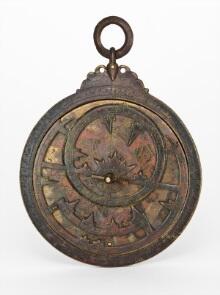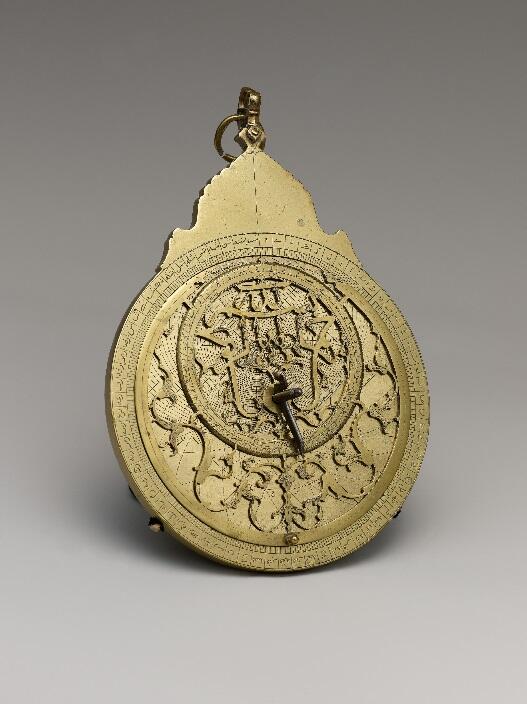The process of art creation consists of several crucial aspects, which include reasoning that the author has for developing a particular idea. The art piece discussed in this paper belongs to the Abbasid period and was created by Hamid ibn al-Khidr al-Khujandi in the 10th century. This planispheric astrolabe served a practical purpose for its creator, and thus, to fully understand the work one must examine particular components that contribute to the creation of meaningful art objects. The planispheric brass astrolabe chosen for this research served a practical purpose to its creator and should be examined with an understanding of historical and cultural events of the 10th century.
Description
The art piece in question is a planispheric astrolabe made out of brass. It is a round object with several circles and a clock face. Various geometric forms are present across the surface of the astrolabe. Yalman states that it is a distinct characteristic of the 10th-century Islamic art as “pseudo-vegetal forms” were commonly used, which can be seen in this piece as well. This aspect of the object that is reminiscent of modern watches is crucial because it determines the practical purpose that was the primary objective of the astrolabe’s creation.
The color of the astrolabe is conditioned by the material used to make it. The size is relatively small, as the astrolabe is measured at approximately fifteen centimeters in diameter. According to the Museum of Islamic Art, the author’s signature can be seen on this astrolabe. Image 1 presents a photo of the planispheric astrolabe in question.

History
Little is known about the history of this planispheric astrolabe. According to the description of the exhibit provided by the Museum of Islamic Art, Hamid ibn al-Khidr al-Khujandi was the creator of this object. He was an astronomer and a mathematician, which can provide an understanding of the origins of the astrolabe in question. Primarily, he was concerned with astronomy as most of the author’s life he worked in an observatory in Ray. The object was constructed in the 10th century within the territory of modern Iraq and Iran. Currently, it can be seen in the Museum of Islamic Art situated in Doha, Qatar. It is unknown how the planispheric brass astrolabe was created.
However, the planispheric astrolabes represent an essential aspect of the cultural development of Islamic nations. Yalman states that “the first three centuries of Abbasid rule were a golden age in which Baghdad and Samarra functioned as the cultural and commercial capitals of the Islamic world.” It is because a particular style of art object creation emerged on this territory, which later affected other nations within the land in both art and architecture. Thus, the ornaments that can be seen in al-Khujandi’s creation provide an understanding of various art forms and approaches that were prevalent in the era.
Purpose
Art and science were unified in this brass planispheric astrolabe. It should be noted that in the period of the Abbasid caliphate, Islamic astronomers made some critical discoveries regarding planets and their movements. Astrology was part of astronomy at that time and was concerned with the influence of plants on things that take place on earth. It can be argued that the interest of the Islamic scientists of the era in these subjects affected the creation of the brass astrolabe.
According to Abbasi and Sarma, three main objects were applied by the scientists in their work – astrolabes, ephemeris, and dust board. Out of the three, astrolabes were the most complex in creation and purpose. The primary objective of their studies was observation and calculation, for which the mentioned tools were used.
Astrolabes did not serve solely as art objects for their owners or creators. Astronomers used them to identify the positions of planets at a particular period. The diameter of this specific astrolabe is 15 cm. It is necessary to note that small astrolabes could not fulfill their astronomical function due to their size; thus, they were primarily used to identify timeframes.
Typically, the material for these objects was either silver or brass.
Astrolabes in Islamic Art
The instrument in question was commonly used within Islamic territories for many centuries. According to Abbasi and Sarma astrolabes had significant value in medieval times. The objects “display a fine combination of geometrical precision, high level of esthetic craft, and aesthetic beauty.” It is a representation of a celestial sphere, which was sometimes used to identify the time of prayer and the direction in which Mecca could be found.
However, the object was developed in ancient Greece before being popularized on Islamic territories. Thus, the planispheric brass astrolabe displays essential aspects of Islamic culture development. The combination of aesthetics and science are the primary distinguishing features of the object.
Comparison
Another example of a planispheric astrolabe can be seen in the Metropolitan Museum of Art. It is an art piece created by Muhammad Zaman al-Munajjim al-Asturlabi in the territory of Iran. The object is more well preserved, possibly because it was built later than the brass astrolabe. The description of the exhibit indicates that this object, similar to the one created by al-Khujandi, could not fulfill the purpose of planetary observation due to its small size. Thus, it is hypothesized that the object was used to determine the time, as a predecessor of modern watches. It was done by calculating “the position of a planet relative to the different astrological houses.”
The surface of the astrolabe displayed in the Metropolitan Museum features calligraphic writing that can be translated as “In the name of God, the Merciful, the Compassionate,” which differs from the brass astrolabe. Both objects have a similar size of approximately fifteen centimeters in diameter. Additionally, the objects are made out of metal; however, this astrolabe includes a combination of brass and steel. Image 2 displays the planispheric astrolabe from the Metropolitan Museum.
The construction of two astrolabes is similar, as both are round with several circles curved inside the objects’ surface. When compared to the planispheric brass astrolabe, the one created by al-Asturlabi features different ornaments, that was prevalent in the era of the author. Thus, rounded figures can be seen in this art piece, which are the primary features that distinguish this object from the creation of al-Khujandi. When comparing the two objects, it can be argued that although they are similar in form and purpose, the distinct ornaments of each represent cultural differences of the two eras.

Conclusion
Overall, the planispheric brass astrolabe created by Hamid ibn al-Khidr al-Khujandi was used by the author in this scientific researches and features ornaments, specific to the 10th century Abbasid caliphate. Astrolabes served a purpose for the astronomers and astrologists on Islamic territories of the era. When compared to a similar object, the distinct features of the astrolabe created by al-Asturlabi can be seen. Primarily, the ornaments on two pieces examined in the paper differ because al-Khujandi uses geometrical forms in his work.
Bibliography
Abbasi, Mubashir ul-Haq, and Sreeramula Rajeswara Sarma. “An Astrolabe by Muḥammad Muqīm of Lahore Dated 1047 AH (1637-38 CE.” Islamic Studies 53, no. 1/2 (2014): 37-65. Web.
Planispheric Astrolabe. Digital Image. The Metropolitan Museum of Art. Web.
Planispheric Astrolabe. Digital Image. The Museum of Islamic Art. Web.
“Planispheric Astrolabe.” The Museum of Islamic Art. Web.
Yalmen, Suzan. “The Art of the Abbasid Period (750–1258).” The Metropolitan Museum of Art. 2018. Web.